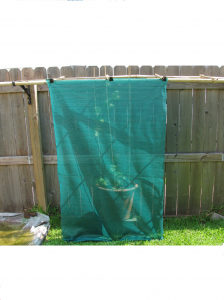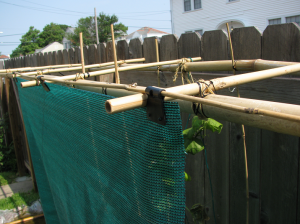First-year plants can sometimes succumb to intensive heat in the summer, especially in July and August. Mirlitons are vigorous vegetative growers but sometimes get ahead of root-growth necessary to uptake moisture. Keep in mind that most garden vegetables do not have the exposure to heat and water-loss that mirlitons have: one vine, even at this early stage of growth, can have hundreds of square feet of leaf space. Roots have to supply the these leaves with a tremendous amount of water since water evaporation, called transpiration, is an integral part of photosynthesis and leaf helps regulate plant temperature reduce internal heat. Most mirliton water uptake occurs at night, so watering the leaves directly–giving them a “good bath”–does not provide much water to the plant.
A plant that exhibits leaf wilting and drooping in the last afternoon heat can be a sign of dehydration. First-year plants tend to wilt occasionally during the heat of the day and then regain leaf shape in the evening. As long as the plant has adequate moisture (test the soil around the base of the plant) and is not waterlogged (too much water), then a little wilting is not a problem, especially if it rapidly regains shape as temperatures cool. But if your plant is properly watered and is wilting extensively during the day, consider protecting it with a standard garden shade cloth. You can but these by the roll or by the yard at most big-box stores: for gardening purposes, these will be rated at blocking out from 60% to 70% of the sun, while allowing water to pass through and air to circulate.
Some of our growers have experimented with shade systems. Bernardez Marcus, a member of the Capital Area Technical College in Baton Rouge, directs our heirloom mirliton project at the Louisiana State Penitentiary at Angola. Marcus reports that they were losing plants to the heat this summer, but when they covered their horizontal trellis with shade cloth, the plants quickly began to flourish. How long you need to cover the plant depends on how well it responds to the shade covering–in the long run the plant will need more sun than the shade cloth permits during long-term use. But it is safe to say that the plant will no longer need the protection in September. Shade cloths absorb heat so keep the cloth a few inches above the plant if possible. In this post, I have included a photo of a vertical shade that I used one year on a young plant.
So if you are planting in full sun, consider shade cloth for first-year plants. ( A special thanks to Marcus and the inmates at Angola who developed and tested this technique).

